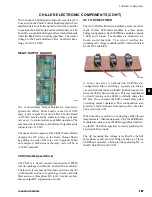
156
JOHNSON CONTROLS
FORM 201.21-NM4 (1020)
156
JOHNSON CONTROLS
TECHNICAL DATA
The Chiller Control Board is the controller and
master decision maker in the control panel. The on-
board microprocessor control is capable of controlling
up to 4 compressors. System inputs from pressure
transducers and temperature sensors are connected
directly to the Chiller Control Board. The Chiller
Control Board circuitry multiplexes all of the analog
inputs, digitizes them, and scans the inputs to keep a
constant watch on chiller operating conditions. Based
on this information, the Chiller Control Board issues
commands to the Relay Output Board(s), Drain/Feed
Valve Controller, and VSD Logic Board to activate
and de-activate contactors, solenoids, control valves,
set compressor speeds, etc., for chilled liquid and
safety control. Keypad commands are acted upon by
the Chiller Control Board micro to change setpoints,
cutouts, scheduling, operating requirements, and to
provide displays.
The Chiller Control Board contains a Real Time Clock
integrated circuit chip with an internal battery back up
of 8K x 8 bit RAM. The purpose of the battery backed
RAM is to assure any programmed values (setpoints,
clock, cutouts, history data etc.) are not lost during a
power failure, regardless of the time involved in a power
outage or shutdown period.
The Chiller Control (Microprocessor) Board contains an
onboard power supply, which provides 5VDC regulated
to sensors, transducers, display, and other circuit boards.
The supply also pr12VDC to the Relay Output
Boards and the +34VDC to the level sensors.
The Chiller Control Board is capable of directly
receiving analog inputs from temperature sensors and
transducers. An analog to digital converter (A/D) with
an onboard 4 channel multiplexer (MUX) allows up to
48 analog inputs to be read. The A/D Converter converts
the analog signals to digital signals, which can be read
by the onboard microprocessor. On a 2 system chiller,
approximately half of these inputs are utilized.
Three integrated circuits on the microprocessor can be
configured for digital inputs or outputs (Digital I/O).
As inputs, they can read digital (2 level, on/off) inputs
like keypad keys, unit switch, high pressure cut-out,
flow switch, etc. As outputs they are used for controls
like turning on fans, controlling compressor heaters,
controlling chiller valves, or other devices requiring
on/off control. Up to 72 Digital I/O will be utilized to
control the chiller.
The Chiller Control (Microprocessor) Board contains
a dual UART (Universal Asynchronous Receiver
Transmitter) for RS-485 and RS-232 communications.
UART1 is configured for RCC and ISN communica
-
tions on the external chiller RS-485 port. Data is sent
and received at 4800 baud with 1 start bit, 8 data bits,
odd parity, and 1 stop bit. The port is shared with the
RS-232 interface and at start-up will be initialized to
RS-485 communications. UART2 is configured for
VSD communications over an internal chiller RS-485
port located within the Control/Power cabinet. UART2
has a higher priority interrupt than UART1. The data
is sent and received at a rate of 9600 baud and serves
only as the communications between the Chiller Control
Board and the VSD Logic Board. Both of these boards
are located within the Control/Power panel.
On power-up, the Chiller Control Board will attempt to
initialize communications with the VSD Logic Board.
The Chiller Control Board will request the number of
compressors select and VSD software version. If for
some reason the information is not provided, the request
will be made over and over again until it is received.
Once the data has been received, the Chiller Control
Board will not ask for it again. If the communications
is not established, a VSD Loss Of Comms fault message
will appear on the STATUS display.
CHILLER CONTROL BOARD
50079
RTC
CHILLER ELECTRONIC COMPONENTS (CON'T)
















































